Abstract
Myocardial oxygen consumption is regulated by interrelated mechanical and inotropic conditions; there is a parallel increase in the aerobic metabolism and inotropic state during beta-adrenergic stimulation under fixed mechanical conditions. In contrast, there is some evidence that beta-blockade may reduce oxygen consumption through effects independent of its influence on mechanical conditions and contractile state, and that prolonged beta-blockade may sensitize the myocardium to beta-adrenergic stimulation. To clarify these two points, the present study examined the relationship of myocardial energetics to mechanics and inotropism during acute beta-blockade and after the withdrawal of long-term beta-blockade, whereupon the basis for any effect observed was sought by characterizing the number, affinity, and affinity states of the beta-receptors as well as the coupling of activated beta-receptors to cyclic AMP generation. Studies of right ventricular papillary muscles from control and chronically beta-blocked cats demonstrated contractile and energetic properties as well as dose-response behavior and inotropic specificity suggestive of an increase in myocardial sensitivity to beta-adrenoceptor stimulation in the latter group. Assays of cardiac beta-adrenoceptors from further groups of control and pretreated cats, both in cardiac tissue and in isolated cardiac muscle cells, failed to define a difference between the two groups either in terms of receptor number and affinity or in terms of the proportion of receptors in the high-affinity state. However, coupling of the activated beta-adrenoceptors to cyclic AMP generation was enhanced in cardiac muscle cells from chronically beta-blocked cats. These data demonstrate that beta-adrenoceptor blockade (a) produces parallel effects on inotropic state and oxygen consumption without an independent effect on either and (b) increases myocardial sensitivity to beta-adrenergic stimulation after beta-blockade withdrawal, not by "up-regulation" of the cardiac beta-adrenoceptors, but instead by more effective coupling of these receptors when activated to cyclic AMP generation.
Full text
PDF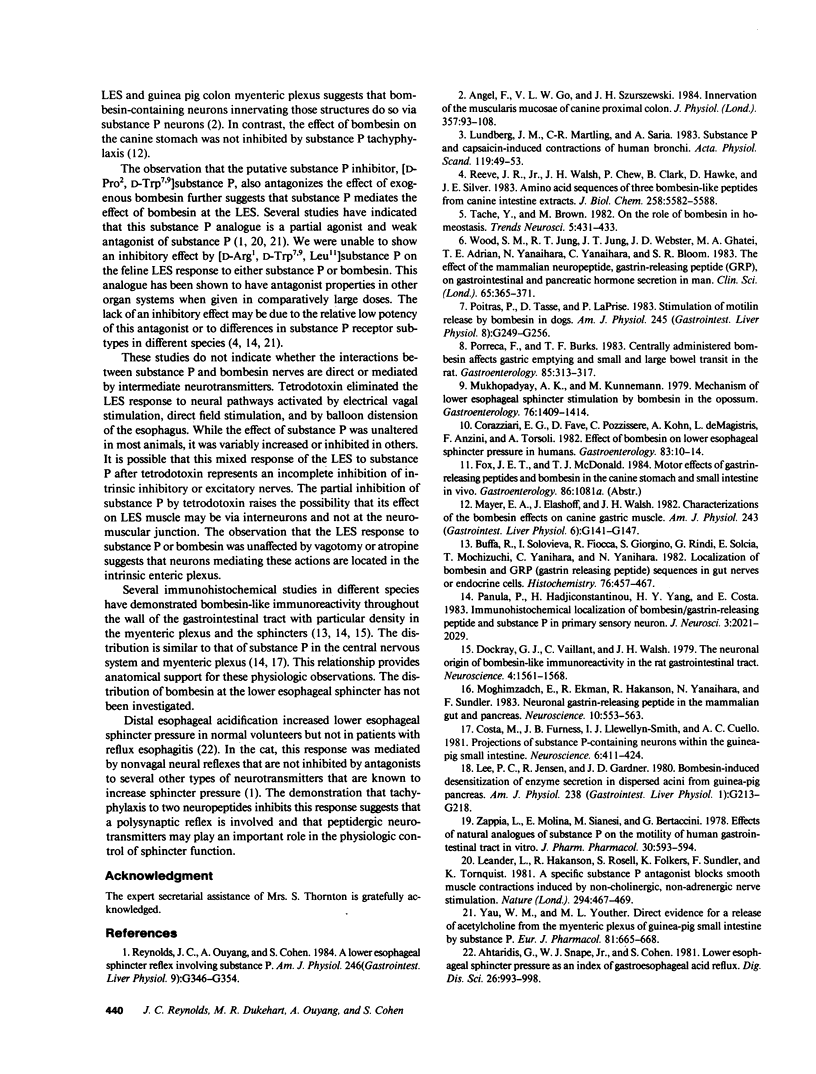
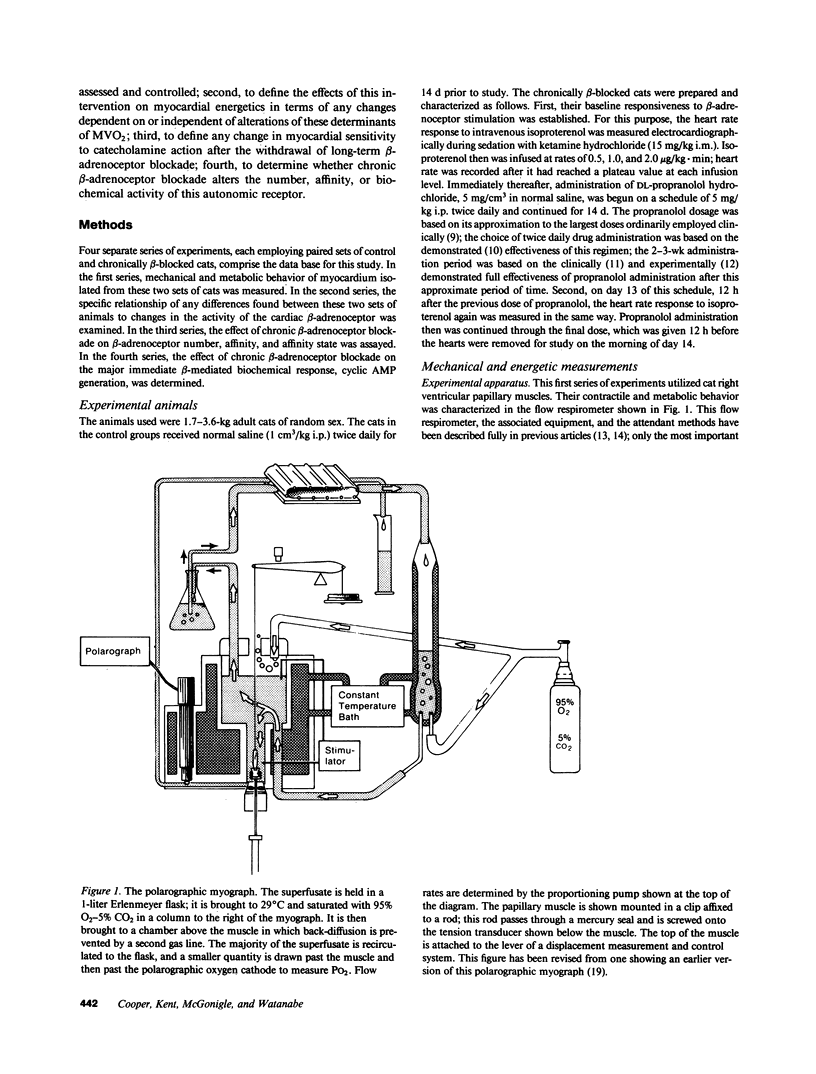

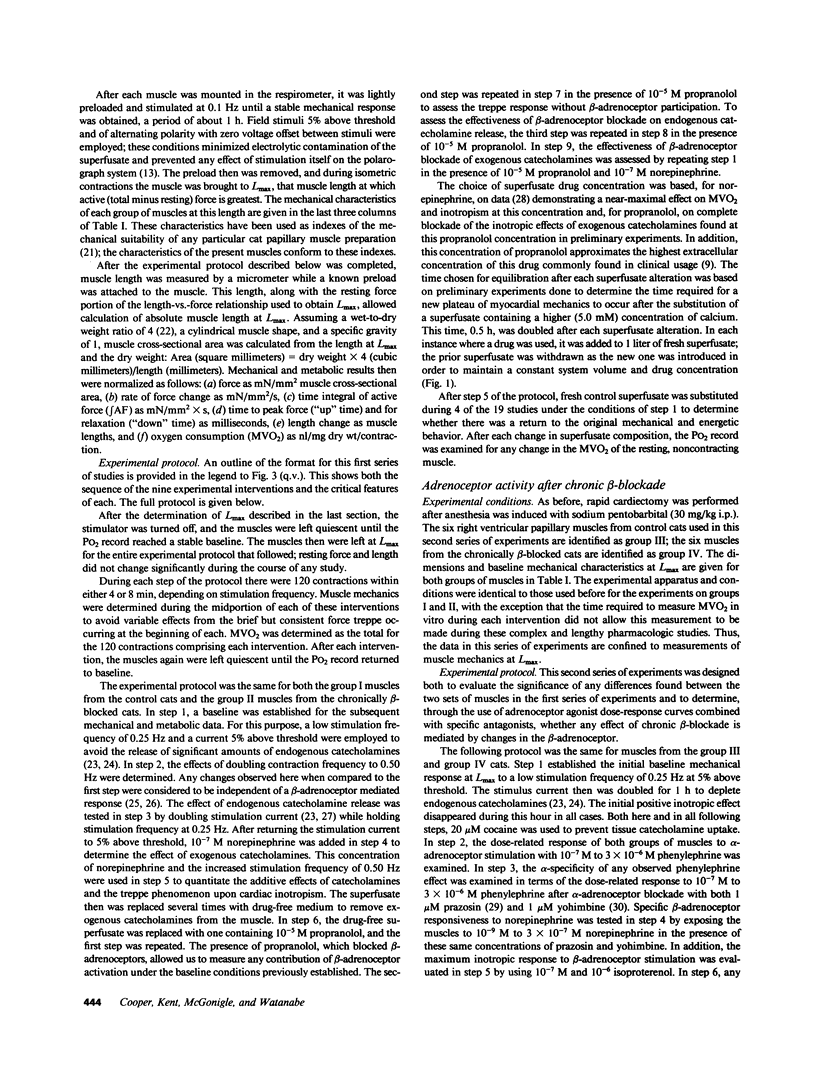
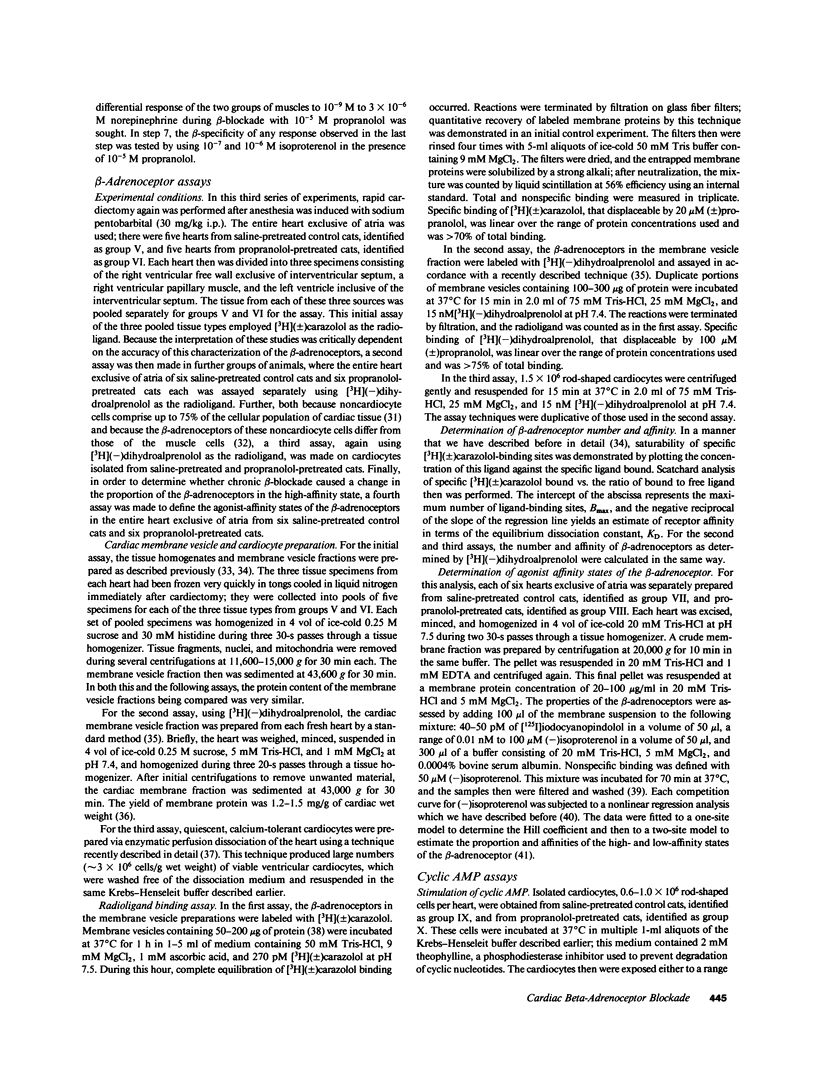
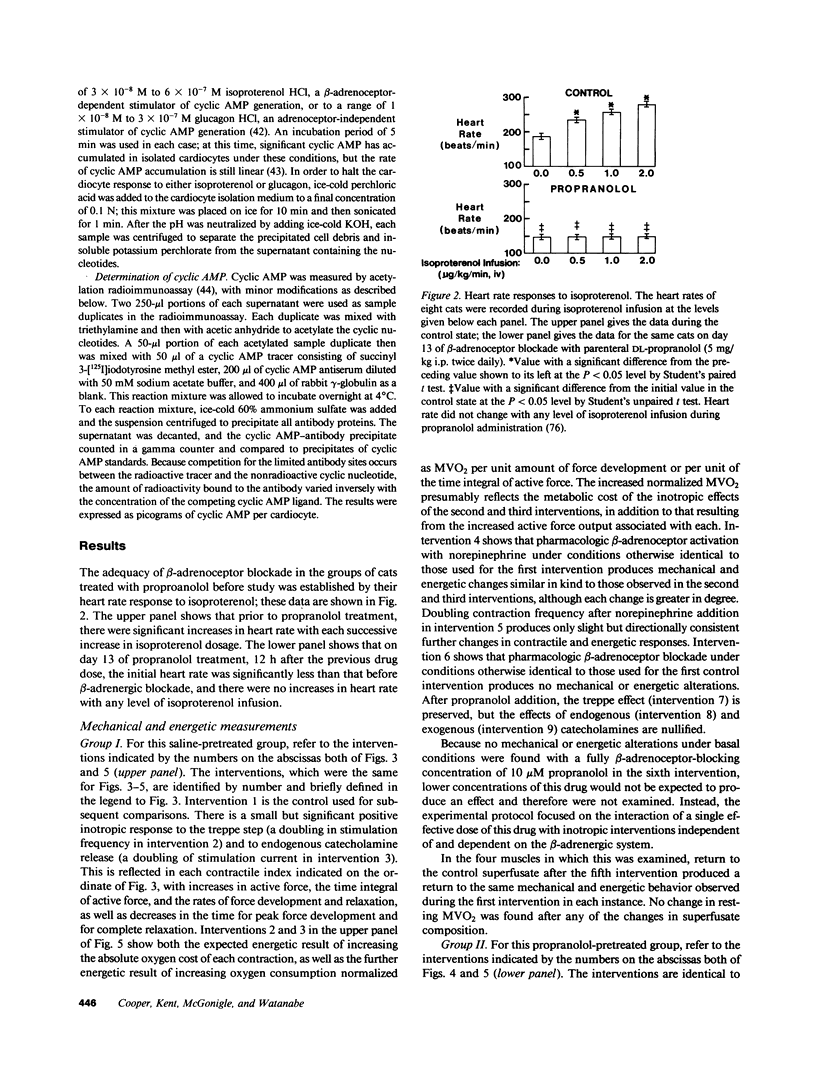
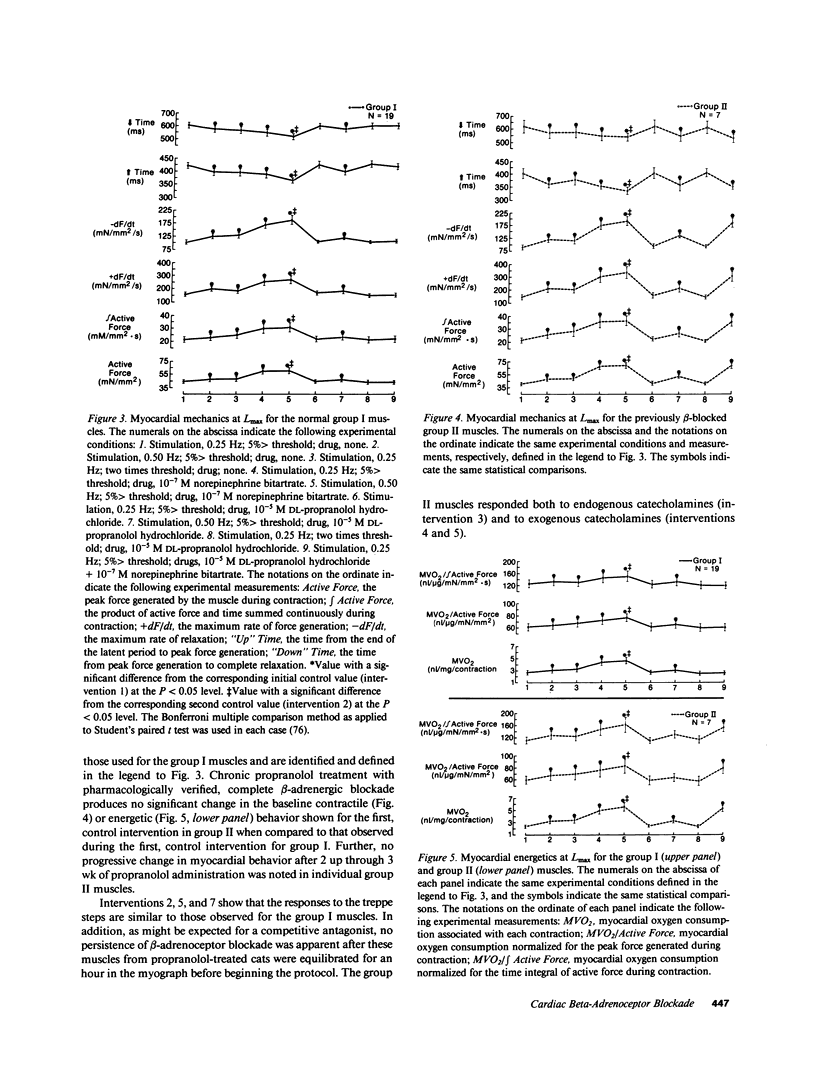

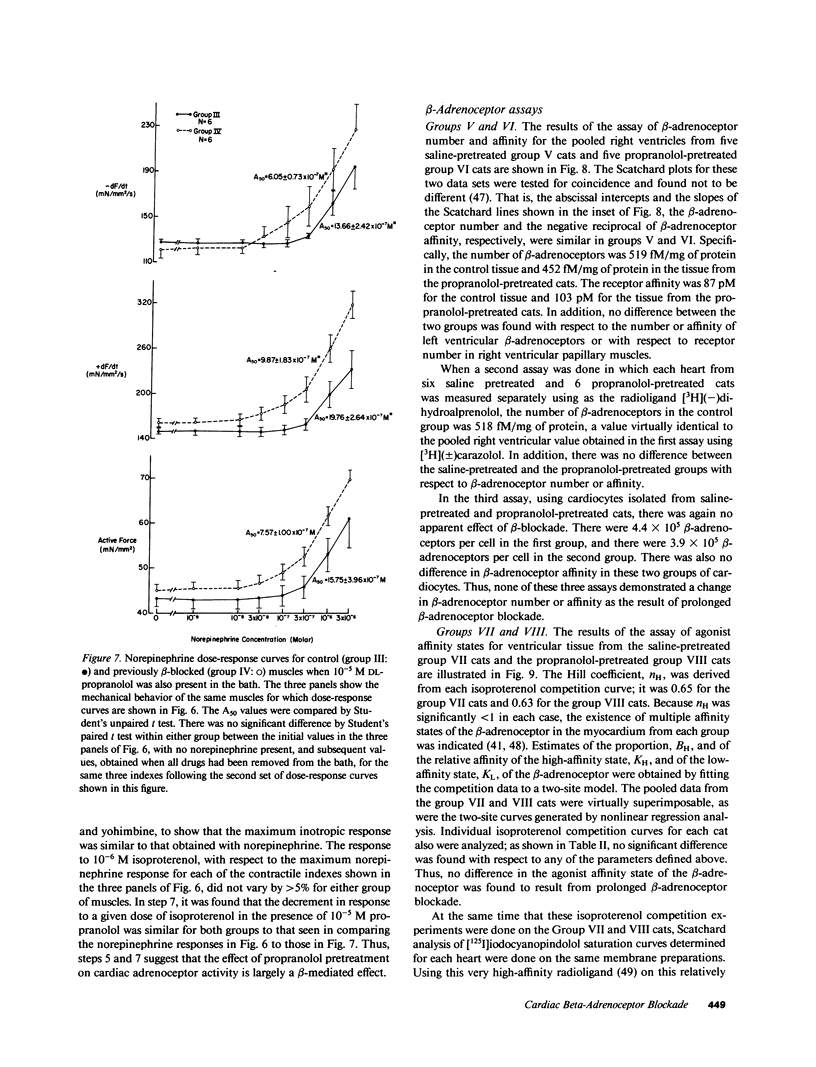
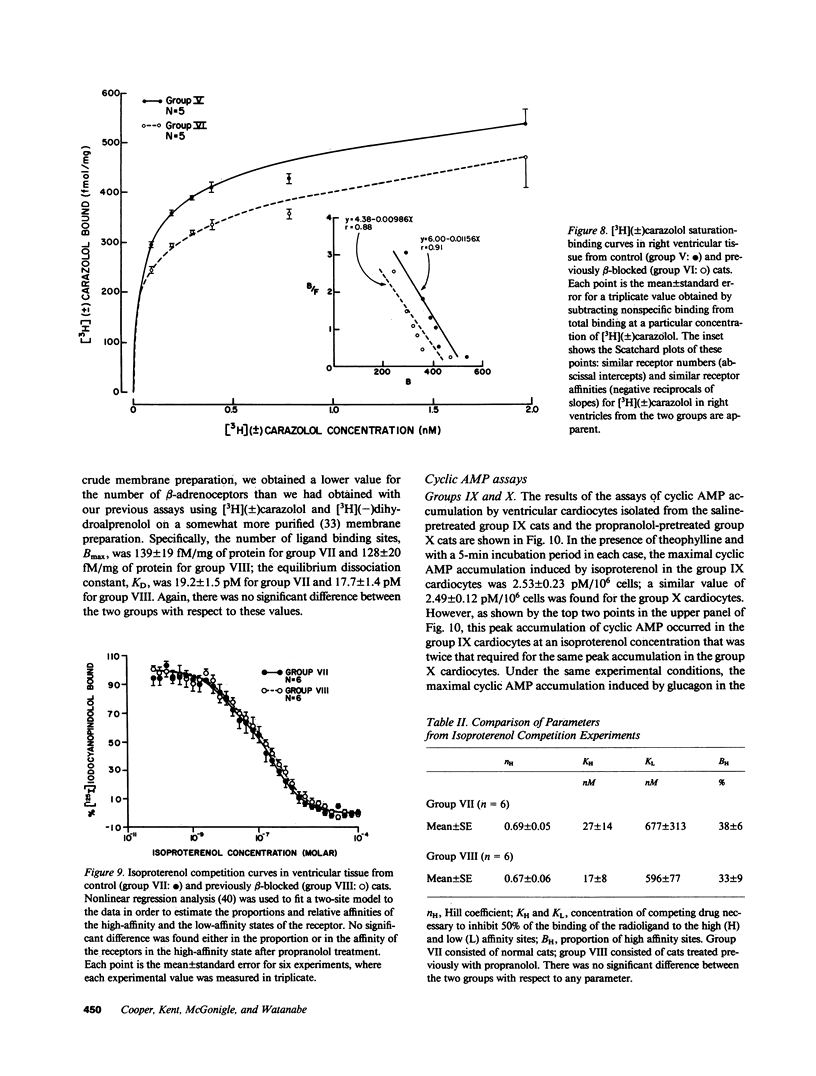
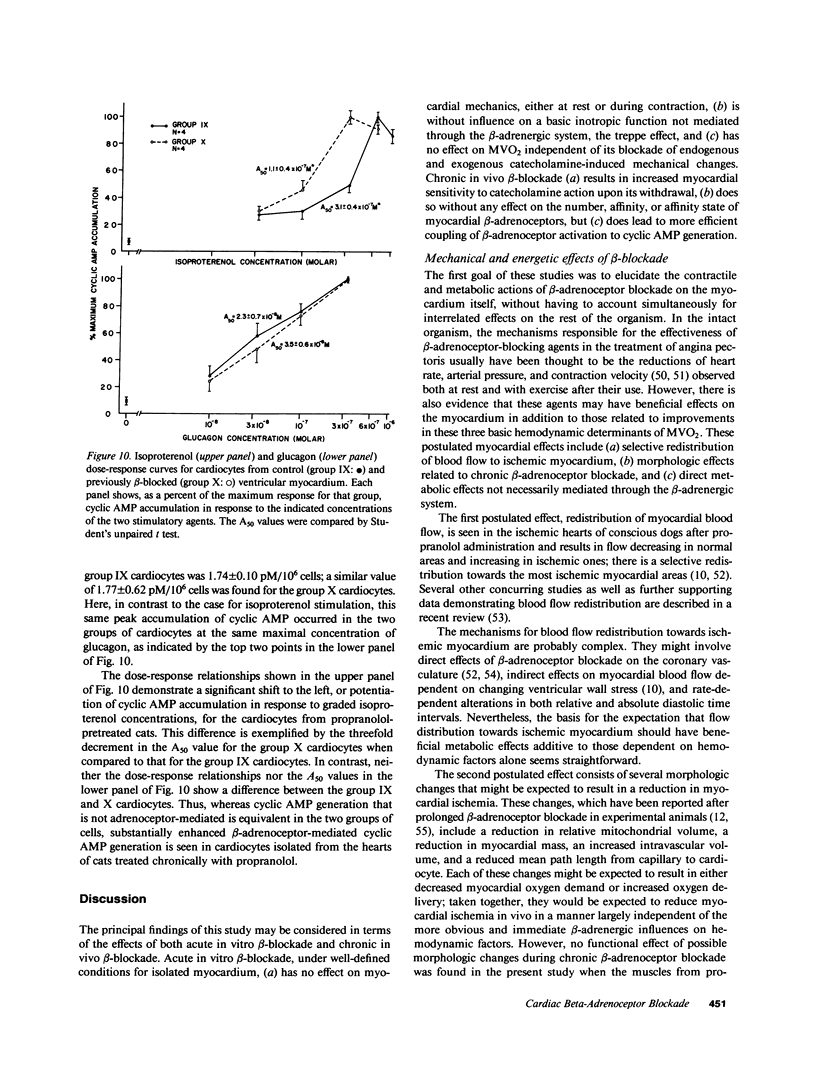
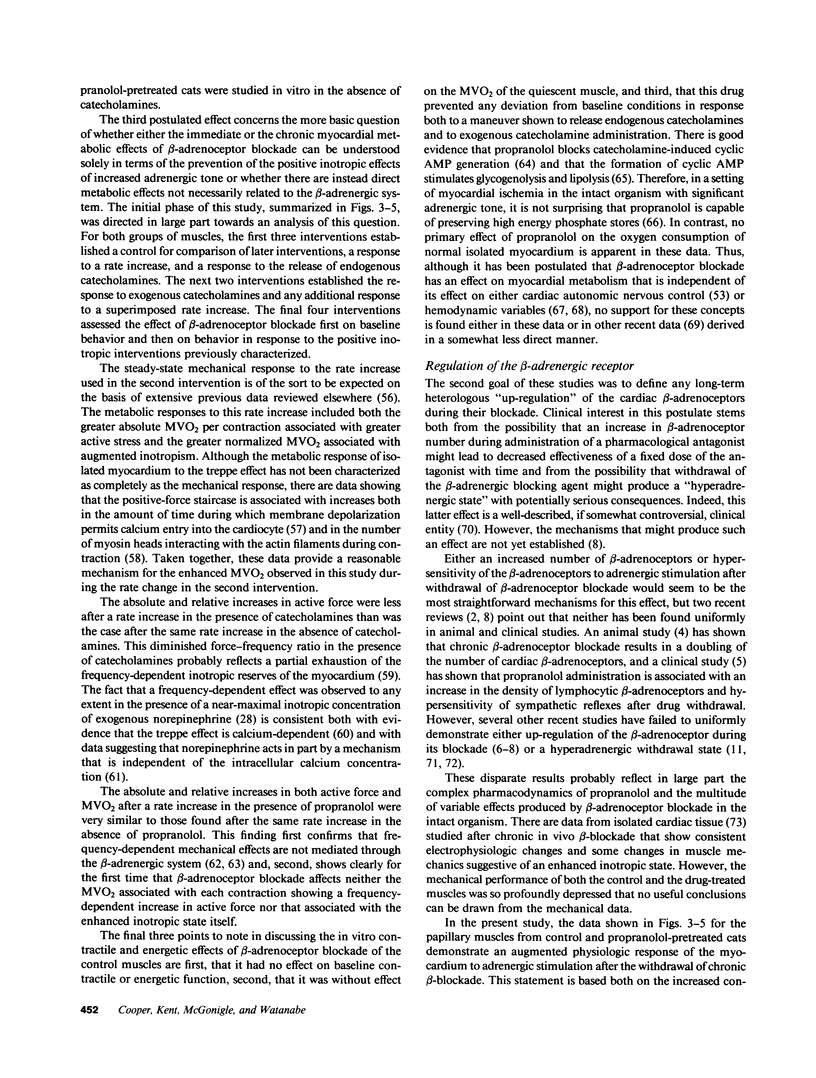
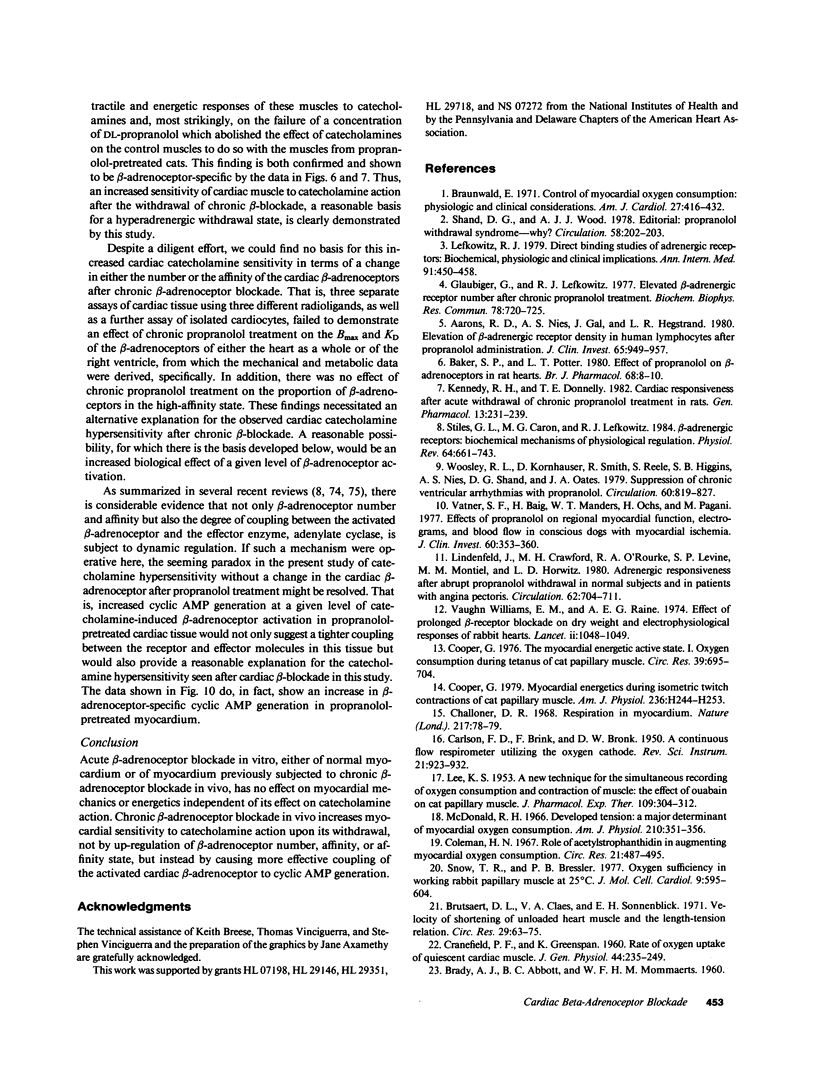
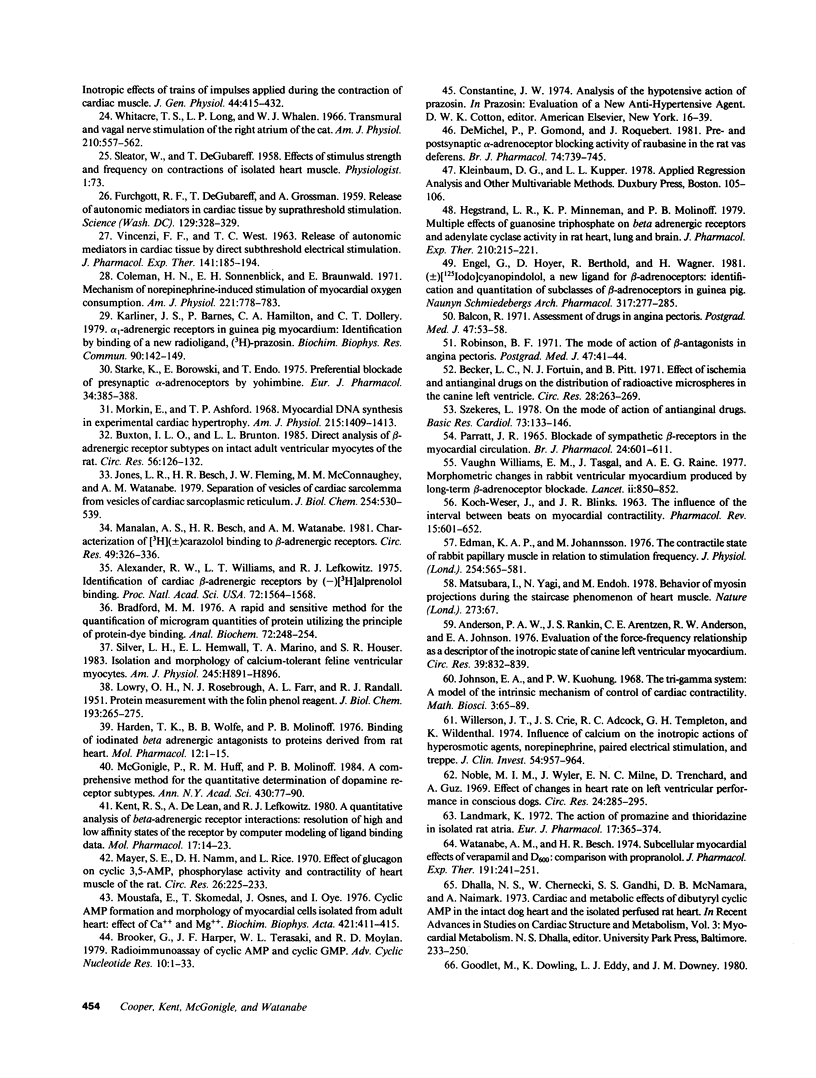
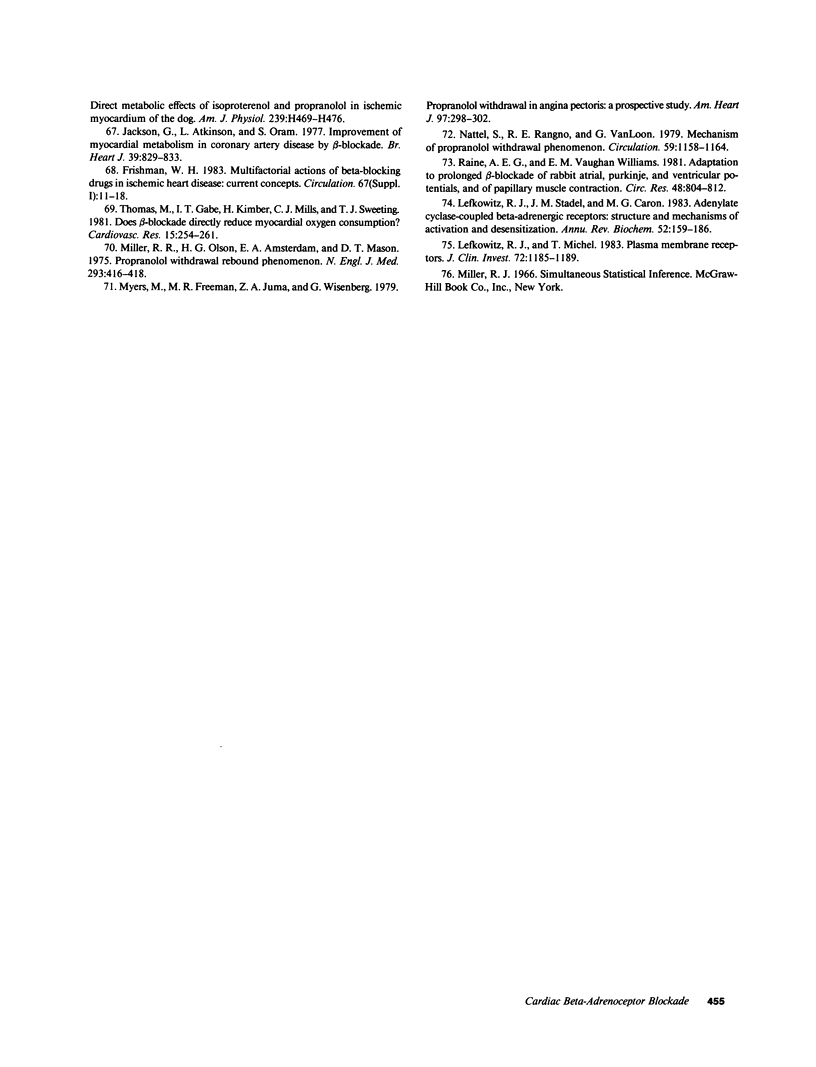
Selected References
These references are in PubMed. This may not be the complete list of references from this article.
- Aarons R. D., Nies A. S., Gal J., Hegstrand L. R., Molinoff P. B. Elevation of beta-adrenergic receptor density in human lymphocytes after propranolol administration. J Clin Invest. 1980 May;65(5):949–957. doi: 10.1172/JCI109781. [DOI] [PMC free article] [PubMed] [Google Scholar]
- Ahtaridis G., Snape W. J., Jr, Cohen S. Lower esophageal sphincter pressure as an index of gastroesophageal acid reflux. Dig Dis Sci. 1981 Nov;26(11):993–998. doi: 10.1007/BF01314761. [DOI] [PubMed] [Google Scholar]
- Alexander R. W., Williams L. T., Lefkowitz R. J. Identification of cardiac beta-adrenergic receptors by (minus) [3H]alprenolol binding. Proc Natl Acad Sci U S A. 1975 Apr;72(4):1564–1568. doi: 10.1073/pnas.72.4.1564. [DOI] [PMC free article] [PubMed] [Google Scholar]
- Anderson P. A., Rankin J. S., Arentzen C. E., Anderson R. W., Johnson E. A. Evaluation of the force-frequency relationship as a descriptor of the inotropic state of canine left ventricular myocardium. Circ Res. 1976 Dec;39(6):832–839. doi: 10.1161/01.res.39.6.832. [DOI] [PubMed] [Google Scholar]
- Angel F., Go V. L., Szurszewski J. H. Innervation of the muscularis mucosae of canine proximal colon. J Physiol. 1984 Dec;357:93–108. doi: 10.1113/jphysiol.1984.sp015491. [DOI] [PMC free article] [PubMed] [Google Scholar]
- Baker S. P., Potter L. T. Effect of propranolol on beta-adrenoceptors in rat hearts. Br J Pharmacol. 1980 Jan;68(1):8–10. doi: 10.1111/j.1476-5381.1980.tb10689.x. [DOI] [PMC free article] [PubMed] [Google Scholar]
- Becker L. C., Fortuin N. J., Pitt B. Effect of ischemia and antianginal drugs on the distribution of radioactive microspheres in the canine left ventricle. Circ Res. 1971 Feb;28(2):263–269. doi: 10.1161/01.res.28.2.263. [DOI] [PubMed] [Google Scholar]
- Bradford M. M. A rapid and sensitive method for the quantitation of microgram quantities of protein utilizing the principle of protein-dye binding. Anal Biochem. 1976 May 7;72:248–254. doi: 10.1016/0003-2697(76)90527-3. [DOI] [PubMed] [Google Scholar]
- Braunwald E. Control of myocardial oxygen consumption: physiologic and clinical considerations. Am J Cardiol. 1971 Apr;27(4):416–432. doi: 10.1016/0002-9149(71)90439-5. [DOI] [PubMed] [Google Scholar]
- Brooker G., Harper J. F., Terasaki W. L., Moylan R. D. Radioimmunoassay of cyclic AMP and cyclic GMP. Adv Cyclic Nucleotide Res. 1979;10:1–33. [PubMed] [Google Scholar]
- Brutsaert D. L., Claes V. A., Sonnenblick E. H. Velocity of shortening of unloaded heart muscle and the length-tension relation. Circ Res. 1971 Jul;29(1):63–75. doi: 10.1161/01.res.29.1.63. [DOI] [PubMed] [Google Scholar]
- Buffa R., Solovieva I., Fiocca R., Giorgino S., Rindi G., Solcia E., Mochizuchi T., Yanaihara C., Yanaihara N. Localization of bombesin and GRP (gastrin releasing peptide) sequences in gut nerves or endocrine cells. Histochemistry. 1982;76(4):457–467. doi: 10.1007/BF00489901. [DOI] [PubMed] [Google Scholar]
- Buxton I. L., Brunton L. L. Direct analysis of beta-adrenergic receptor subtypes on intact adult ventricular myocytes of the rat. Circ Res. 1985 Jan;56(1):126–132. doi: 10.1161/01.res.56.1.126. [DOI] [PubMed] [Google Scholar]
- CARLSON F. D., BRINK F., Jr, BRONK D. W. A continuous flow respirometer utilizing the oxygen cathode. Rev Sci Instrum. 1950 Nov;21(11):923–932. doi: 10.1063/1.1745465. [DOI] [PubMed] [Google Scholar]
- CRANEFIELD P. F., GREENSPAN K. The rate of oxygen uptake of quiescent cardiac muscle. J Gen Physiol. 1960 Nov;44:235–249. doi: 10.1085/jgp.44.2.235. [DOI] [PMC free article] [PubMed] [Google Scholar]
- Challoner D. R. Respiration in myocardium. Nature. 1968 Jan 6;217(5123):78–79. doi: 10.1038/217078a0. [DOI] [PubMed] [Google Scholar]
- Chatterjee S. S., Perry A. E. Salbutamol: clinical application as pressure-packed aerosol. Postgrad Med J. 1971 Mar;47(Suppl):53–55. [PubMed] [Google Scholar]
- Coleman H. N., 3rd Role of acetylstrophanthidin in augmenting myocardial oxygen consumption. Relation of increased O-2 consumption to changes in velocity of contraction. Circ Res. 1967 Oct;21(4):487–495. doi: 10.1161/01.res.21.4.487. [DOI] [PubMed] [Google Scholar]
- Coleman H. N., Sonnenblick E. H., Braunwald E. Mechanism of norepinephrine-induced stimulation of myocardial oxygen consumption. Am J Physiol. 1971 Sep;221(3):778–783. doi: 10.1152/ajplegacy.1971.221.3.778. [DOI] [PubMed] [Google Scholar]
- Cooper G., 4th Myocardial energetics during isometric twitch contractions of cat papillary muscle. Am J Physiol. 1979 Feb;236(2):H244–H253. doi: 10.1152/ajpheart.1979.236.2.H244. [DOI] [PubMed] [Google Scholar]
- Cooper G., 4th The myocardial energetic active state. I. Oxygen consumption during tetanus of cat papillary muscle. Circ Res. 1976 Nov;39(5):695–704. doi: 10.1161/01.res.39.5.695. [DOI] [PubMed] [Google Scholar]
- Corazziari E., Delle Fave G., Pozzessere C., Kohn A., de Magistris L., Anzini F., Torsoli A. Effect of bombesin on lower esophageal sphincter pressure in humans. Gastroenterology. 1982 Jul;83(1 Pt 1):10–14. [PubMed] [Google Scholar]
- Costa M., Furness J. B., Llewellyn-Smith I. J., Cuello A. C. Projections of substance P-containing neurons within the guinea-pig small intestine. Neuroscience. 1981;6(3):411–424. doi: 10.1016/0306-4522(81)90134-2. [DOI] [PubMed] [Google Scholar]
- Demichel P., Gomond P., Roquebert J. Pre- and postsynaptic alpha-adrenoceptor blocking activity of raubasine in the rat vas deferens. Br J Pharmacol. 1981 Dec;74(4):739–745. doi: 10.1111/j.1476-5381.1981.tb10706.x. [DOI] [PMC free article] [PubMed] [Google Scholar]
- Dhalla N. S., Chernecki W., Gandhi S. S., McNamara D. B., Naimark A. Cardiac and metabolic effects of dibutyryl cyclic AMP in the intact dog heart and the isolated perfused rat heart. Recent Adv Stud Cardiac Struct Metab. 1973;3:233–250. [PubMed] [Google Scholar]
- Dockray G. J., Vaillant C., Walsh J. H. The neuronal origin of bombesin-like immunoreactivity in the rat gastrointestinal tract. Neuroscience. 1979;4(11):1561–1568. doi: 10.1016/0306-4522(79)90019-8. [DOI] [PubMed] [Google Scholar]
- Edman K. A., Jóhannsson M. The contractile state of rabbit papillary muscle in relation to stimulation frequency. J Physiol. 1976 Jan;254(3):565–581. doi: 10.1113/jphysiol.1976.sp011247. [DOI] [PMC free article] [PubMed] [Google Scholar]
- Engel G., Hoyer D., Berthold R., Wagner H. (+/-)[125Iodo] cyanopindolol, a new ligand for beta-adrenoceptors: identification and quantitation of subclasses of beta-adrenoceptors in guinea pig. Naunyn Schmiedebergs Arch Pharmacol. 1981;317(4):277–285. doi: 10.1007/BF00501307. [DOI] [PubMed] [Google Scholar]
- FURCHGOTT R. F., DE GUBAREFF T., GROSSMAN A. Release of autonomic mediators in cardiac tissue by suprathreshold stimulation. Science. 1959 Feb 6;129(3345):328–329. doi: 10.1126/science.129.3345.328. [DOI] [PubMed] [Google Scholar]
- Glaubiger G., Lefkowitz R. J. Elevated beta-adrenergic receptor number after chronic propranolol treatment. Biochem Biophys Res Commun. 1977 Sep 23;78(2):720–725. doi: 10.1016/0006-291x(77)90238-8. [DOI] [PubMed] [Google Scholar]
- Goodlett M., Dowling K., Eddy L. J., Downey J. M. Direct metabolic effects of isoproterenol and propranolol in ischemic myocardium of the dog. Am J Physiol. 1980 Oct;239(4):H469–H476. doi: 10.1152/ajpheart.1980.239.4.H469. [DOI] [PubMed] [Google Scholar]
- Harden T. K., Wolfe B. B., Molinoff P. B. Binding of iodinated beta adrenergic antagonists to proteins derived from rat heart. Mol Pharmacol. 1976 Jan;12(1):1–15. [PubMed] [Google Scholar]
- Hegstrand L. R., Minneman K. P., Molinoff P. B. Multiple effects of guanosine triphosphate on beta adrenergic receptors and adenylate cyclase activity in rat heart, lung and brain. J Pharmacol Exp Ther. 1979 Aug;210(2):215–221. [PubMed] [Google Scholar]
- Jackson G., Atkinson L., Oram S. Improvement of myocardial metabolism in coronary arterial disease by beta-blockade. Br Heart J. 1977 Aug;39(8):829–833. doi: 10.1136/hrt.39.8.829. [DOI] [PMC free article] [PubMed] [Google Scholar]
- Jones L. R., Besch H. R., Jr, Fleming J. W., McConnaughey M. M., Watanabe A. M. Separation of vesicles of cardiac sarcolemma from vesicles of cardiac sarcoplasmic reticulum. Comparative biochemical analysis of component activities. J Biol Chem. 1979 Jan 25;254(2):530–539. [PubMed] [Google Scholar]
- KOCH-WESER J., BLINKS J. R. THE INFLUENCE OF THE INTERVAL BETWEEN BEATS ON MYOCARDIAL CONTRACTILITY. Pharmacol Rev. 1963 Sep;15:601–652. [PubMed] [Google Scholar]
- Karliner J. S., Barnes P., Hamilton C. A., Dollery C. T. alpha 1-Adrenergic receptors in guinea pig myocardium: identification by binding of a new radioligand, (3H)-prazosin. Biochem Biophys Res Commun. 1979 Sep 12;90(1):142–149. doi: 10.1016/0006-291x(79)91601-2. [DOI] [PubMed] [Google Scholar]
- Kennedy R. H., Donnelly T. E., Jr Cardiac responsiveness after acute withdrawal of chronic propranolol treatment in rats. Gen Pharmacol. 1982;13(3):231–239. doi: 10.1016/0306-3623(82)90094-5. [DOI] [PubMed] [Google Scholar]
- Kent R. S., De Lean A., Lefkowitz R. J. A quantitative analysis of beta-adrenergic receptor interactions: resolution of high and low affinity states of the receptor by computer modeling of ligand binding data. Mol Pharmacol. 1980 Jan;17(1):14–23. [PubMed] [Google Scholar]
- Kirby W. M., De Maine J. B., Serrill W. S. Pharmacokinetics of the cephalosporins in healthy volunteers and uremic patients. Postgrad Med J. 1971 Feb;47(Suppl):41–46. [PubMed] [Google Scholar]
- LEE K. S. A new technique for the simultaneous recording of oxygen consumption and contraction of muscle: the effect of ouabain on cat papillary muscle. J Pharmacol Exp Ther. 1953 Nov;109(3):304–312. [PubMed] [Google Scholar]
- LOWRY O. H., ROSEBROUGH N. J., FARR A. L., RANDALL R. J. Protein measurement with the Folin phenol reagent. J Biol Chem. 1951 Nov;193(1):265–275. [PubMed] [Google Scholar]
- Landmark K. The action of promazine and thioridazine in isolated rat atria. 3. Effects of varying concentrations of calcium and different frequencies and strengths of stimulation on contractile force and excitability. Eur J Pharmacol. 1972 Mar;17(3):365–374. doi: 10.1016/0014-2999(72)90117-3. [DOI] [PubMed] [Google Scholar]
- Leander S., Håkanson R., Rosell S., Folkers K., Sundler F., Tornqvist K. A specific substance P antagonist blocks smooth muscle contractions induced by non-cholinergic, non-adrenergic nerve stimulation. Nature. 1981 Dec 3;294(5840):467–469. doi: 10.1038/294467a0. [DOI] [PubMed] [Google Scholar]
- Lee P. C., Jensen R. T., Gardner J. D. Bombesin-induced desensitization of enzyme secretion in dispersed acini from guinea pig pancreas. Am J Physiol. 1980 Mar;238(3):G213–G218. doi: 10.1152/ajpgi.1980.238.3.G213. [DOI] [PubMed] [Google Scholar]
- Lefkowitz R. J. Direct binding studies of adrenergic receptors: biochemical, physiologic, and clinical implications. Ann Intern Med. 1979 Sep;91(3):450–458. doi: 10.7326/0003-4819-91-3-450. [DOI] [PubMed] [Google Scholar]
- Lefkowitz R. J., Michel T. Plasma membrane receptors. J Clin Invest. 1983 Oct;72(4):1185–1189. doi: 10.1172/JCI111073. [DOI] [PMC free article] [PubMed] [Google Scholar]
- Lefkowitz R. J., Stadel J. M., Caron M. G. Adenylate cyclase-coupled beta-adrenergic receptors: structure and mechanisms of activation and desensitization. Annu Rev Biochem. 1983;52:159–186. doi: 10.1146/annurev.bi.52.070183.001111. [DOI] [PubMed] [Google Scholar]
- Lindenfeld J., Crawford M. H., O'Rourke R. A., Levine S. P., Montiel M. M., Horwitz L. D. Adrenergic responsiveness after abrupt propranolol withdrawal in normal subjects and in patients with angina pectoris. Circulation. 1980 Oct;62(4):704–711. doi: 10.1161/01.cir.62.4.704. [DOI] [PubMed] [Google Scholar]
- Lundberg J. M., Martling C. R., Saria A. Substance P and capsaicin-induced contraction of human bronchi. Acta Physiol Scand. 1983 Sep;119(1):49–53. doi: 10.1111/j.1748-1716.1983.tb07304.x. [DOI] [PubMed] [Google Scholar]
- Manalan A. S., Besch H. R., Jr, Watanabe A. M. Characterization of [3H](+/-)carazolol binding to beta-adrenergic receptors. Application to study of beta-adrenergic receptor subtypes in canine ventricular myocardium and lung. Circ Res. 1981 Aug;49(2):326–336. doi: 10.1161/01.res.49.2.326. [DOI] [PubMed] [Google Scholar]
- Mayer E. A., Elashoff J., Walsh J. H. Characterization of bombesin effects on canine gastric muscle. Am J Physiol. 1982 Aug;243(2):G141–G147. doi: 10.1152/ajpgi.1982.243.2.G141. [DOI] [PubMed] [Google Scholar]
- Mayer S. E., Namm D. H., Rice L. Effect of glucagon on cyclic 3',5'-AMP, phosphorylase activity and contractility of heart muscle of the rat. Circ Res. 1970 Feb;26(2):225–233. doi: 10.1161/01.res.26.2.225. [DOI] [PubMed] [Google Scholar]
- McDonald R. H., Jr Developed tension: a major determinant of myocardial oxygen consumption. Am J Physiol. 1966 Feb;210(2):351–356. doi: 10.1152/ajplegacy.1966.210.2.351. [DOI] [PubMed] [Google Scholar]
- McGonigle P., Huff R. M., Molinoff P. B. A comprehensive method for the quantitative determination of dopamine receptor subtypes. Ann N Y Acad Sci. 1984;430:77–90. doi: 10.1111/j.1749-6632.1984.tb14499.x. [DOI] [PubMed] [Google Scholar]
- Mehra R., Zeiler R. H., Gough W. B., El-Sherif N. Reentrant ventricular arrhythmias in the late myocardial infarction period. 9. Electrophysiologic-anatomic correlation of reentrant circuits. Circulation. 1983 Jan;67(1):11–24. doi: 10.1161/01.cir.67.1.11. [DOI] [PubMed] [Google Scholar]
- Miller R. R., Olson H. G., Amsterdam E. A., Mason D. T. Propranolol-withdrawal rebound phenomenon. Exacerbation of coronary events after abrupt cessation of antianginal therapy. N Engl J Med. 1975 Aug 28;293(9):416–418. doi: 10.1056/NEJM197508282930902. [DOI] [PubMed] [Google Scholar]
- Moghimzadeh E., Ekman R., Håkanson R., Yanaihara N., Sundler F. Neuronal gastrin-releasing peptide in the mammalian gut and pancreas. Neuroscience. 1983 Oct;10(2):553–563. doi: 10.1016/0306-4522(83)90152-5. [DOI] [PubMed] [Google Scholar]
- Morkin E., Ashford T. P. Myocardial DNA synthesis in experimental cardiac hypertrophy. Am J Physiol. 1968 Dec;215(6):1409–1413. doi: 10.1152/ajplegacy.1968.215.6.1409. [DOI] [PubMed] [Google Scholar]
- Moustafa E., Skomedal T., Osnes J. B., Oye I. Cyclic AMP formation and morphology of myocardial cells isolated from adult heart: effect of Ca2+ and Mg2+. Biochim Biophys Acta. 1976 Feb 24;421(2):411–415. doi: 10.1016/0304-4165(76)90308-1. [DOI] [PubMed] [Google Scholar]
- Mukhopadhyay A. K., Kunnemann M. Mechanism of lower esophageal sphincter stimulation by bombesin in the opossum. Gastroenterology. 1979 Jun;76(6):1409–1414. [PubMed] [Google Scholar]
- Myers M. G., Freeman M. R., Juma Z. A., Wisenberg G. Propranolol withdrawal in angina pectoris: a prospective study. Am Heart J. 1979 Mar;97(3):298–302. doi: 10.1016/0002-8703(79)90428-9. [DOI] [PubMed] [Google Scholar]
- Nattel S., Rangno R. E., Van Loon G. Mechanism of propranolol withdrawal phenomena. Circulation. 1979 Jun;59(6):1158–1164. doi: 10.1161/01.cir.59.6.1158. [DOI] [PubMed] [Google Scholar]
- Noble M. I., Wyler J., Milne E. N., Trenchard D., Guz A. Effect of changes in heart rat on left ventricular performance in conscious dogs. Circ Res. 1969 Feb;24(2):285–295. doi: 10.1161/01.res.24.2.285. [DOI] [PubMed] [Google Scholar]
- PARRATT J. R. BLOCKAGE OF SYMPATHETIC BETA-RECEPTORS IN THE MYOCARDIAL CIRCULATION. Br J Pharmacol Chemother. 1965 Jun;24:601–611. doi: 10.1111/j.1476-5381.1965.tb01616.x. [DOI] [PMC free article] [PubMed] [Google Scholar]
- Panula P., Hadjiconstantinou M., Yang H. Y., Costa E. Immunohistochemical localization of bombesin/gastrin-releasing peptide and substance P in primary sensory neurons. J Neurosci. 1983 Oct;3(10):2021–2029. doi: 10.1523/JNEUROSCI.03-10-02021.1983. [DOI] [PMC free article] [PubMed] [Google Scholar]
- Poitras P., Tassé D., Laprise P. Stimulation of motilin release by bombesin in dogs. Am J Physiol. 1983 Aug;245(2):G249–G256. doi: 10.1152/ajpgi.1983.245.2.G249. [DOI] [PubMed] [Google Scholar]
- Porreca F., Burks T. F. Centrally administered bombesin affects gastric emptying and small and large bowel transit in the rat. Gastroenterology. 1983 Aug;85(2):313–317. [PubMed] [Google Scholar]
- Raine A. E., Vaughan Williams E. M. Adaptation to prolonged beta-blockade of rabbit atrial, purkinje, and ventricular potentials, and of papillary muscle contraction. Time-course of development of and recovery from adaptation. Circ Res. 1981 Jun;48(6 Pt 1):804–812. doi: 10.1161/01.res.48.6.804. [DOI] [PubMed] [Google Scholar]
- Reeve J. R., Jr, Walsh J. H., Chew P., Clark B., Hawke D., Shively J. E. Amino acid sequences of three bombesin-like peptides from canine intestine extracts. J Biol Chem. 1983 May 10;258(9):5582–5588. [PubMed] [Google Scholar]
- Reynolds J. C., Ouyang A., Cohen S. A lower esophageal sphincter reflex involving substance P. Am J Physiol. 1984 Apr;246(4 Pt 1):G346–G354. doi: 10.1152/ajpgi.1984.246.4.G346. [DOI] [PubMed] [Google Scholar]
- Shand D. G., Wood A. J. Propranolol withdrawal syndrome - why? Circulation. 1978 Aug;58(2):202–203. doi: 10.1161/01.cir.58.2.202. [DOI] [PubMed] [Google Scholar]
- Silver L. H., Hemwall E. L., Marino T. A., Houser S. R. Isolation and morphology of calcium-tolerant feline ventricular myocytes. Am J Physiol. 1983 Nov;245(5 Pt 1):H891–H896. doi: 10.1152/ajpheart.1983.245.5.H891. [DOI] [PubMed] [Google Scholar]
- Snow T. R., Bressler P. B. Oxygen sufficiency in working rabbit papillary muscle at 35 degrees C. J Mol Cell Cardiol. 1977 Jul;9(7):595–604. doi: 10.1016/s0022-2828(77)80373-8. [DOI] [PubMed] [Google Scholar]
- Starke K., Borowski E., Endo T. Preferential blockade of presynaptic alpha-adrenoceptors by yohimbine. Eur J Pharmacol. 1975 Dec;34(2):385–388. doi: 10.1016/0014-2999(75)90268-x. [DOI] [PubMed] [Google Scholar]
- Stiles G. L., Caron M. G., Lefkowitz R. J. Beta-adrenergic receptors: biochemical mechanisms of physiological regulation. Physiol Rev. 1984 Apr;64(2):661–743. doi: 10.1152/physrev.1984.64.2.661. [DOI] [PubMed] [Google Scholar]
- Szekeres L. On the mode of action of antianginal drugs. Basic Res Cardiol. 1978 Mar-Apr;73(2):133–146. doi: 10.1007/BF01906749. [DOI] [PubMed] [Google Scholar]
- Thomas M., Gabe I. T., Kimber H., Mills C. J., Sweeting T. J. Does beta-blockade directly reduce myocardial oxygen consumption? Cardiovasc Res. 1981 May;15(5):254–261. doi: 10.1093/cvr/15.5.254. [DOI] [PubMed] [Google Scholar]
- VINCENZI F. F., WEST T. C. RELEASE OF AUTONOMIC MEDIATORS IN CARDIAC TISSUE BY DIRECT SUBTHRESHOLD ELECTRICAL STIMULATION. J Pharmacol Exp Ther. 1963 Aug;141:185–194. [PubMed] [Google Scholar]
- Vatner S. F., Baig H., Manders W. T., Ochs H., Pagani M. Effects of propranolol on regional myocardial function, electrograms, and blood flow in conscious dogs with myocardial ischemia. J Clin Invest. 1977 Aug;60(2):353–360. doi: 10.1172/JCI108783. [DOI] [PMC free article] [PubMed] [Google Scholar]
- Watanabe A. M., Besch H. R., Jr Subcellular myocardial effects of verapamil and D600: comparison with propranolol. J Pharmacol Exp Ther. 1974 Nov;191(2):241–251. [PubMed] [Google Scholar]
- Whitacre T. S., Long J. P., Whalen W. J. Transmural and vagal nerve stimulation of the right atrium of the cat. Am J Physiol. 1966 Mar;210(3):557–562. doi: 10.1152/ajplegacy.1966.210.3.557. [DOI] [PubMed] [Google Scholar]
- Willerson J. T., Crie J. S., Adcock R. C., Templeton G. H., Wildenthal K. Influence of calcium on the inotropic actions of hyperosmotic agents, norepinephrine, paired electrical stimulation, and treppe. J Clin Invest. 1974 Oct;54(4):957–964. doi: 10.1172/JCI107836. [DOI] [PMC free article] [PubMed] [Google Scholar]
- Williams E. M., Raine A. E. Effect of prolonged beta-receptor blockade on dry weight and electrophysiological responses of rabbit hearts. Lancet. 1974 Nov 2;2(7888):1048–1049. doi: 10.1016/s0140-6736(74)92154-0. [DOI] [PubMed] [Google Scholar]
- Williams E. M., Tasgal J., Raine A. E. Morphometric changes in rabbit ventricular myocardium produced by long-term beta-adrenoceptor blockade. Lancet. 1977 Oct 22;2(8043):850–852. doi: 10.1016/s0140-6736(77)90784-x. [DOI] [PubMed] [Google Scholar]
- Wood S. M., Jung R. T., Webster J. D., Ghatei M. A., Adrian T. E., Yanaihara N., Yanaihara C., Bloom S. R. The effect of the mammalian neuropeptide, gastrin-releasing peptide (GRP), on gastrointestinal and pancreatic hormone secretion in man. Clin Sci (Lond) 1983 Oct;65(4):365–371. doi: 10.1042/cs0650365. [DOI] [PubMed] [Google Scholar]
- Woosley R. L., Kornhauser D., Smith R., Reele S., Higgins S. B., Nies A. S., Shand D. G., Oates J. A. Suppression of chronic ventricular arrhythmias with propranolol. Circulation. 1979 Oct;60(4):819–827. doi: 10.1161/01.cir.60.4.819. [DOI] [PubMed] [Google Scholar]
- Zappia L., Molina E., Sianesi M., Bertaccini G. Effects of natural analogues of substance P on the motility of human gastrointestinal tract in vitro. J Pharm Pharmacol. 1978 Sep;30(9):593–594. doi: 10.1111/j.2042-7158.1978.tb13335.x. [DOI] [PubMed] [Google Scholar]


